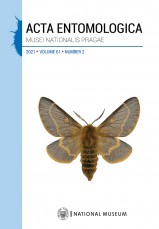The larval structures and bionomics of Idgia iriomoteana (Coleoptera: Prionoceridae)
Asano Makoto
Acta Entomologica Musei Nationalis Pragae 61(2): 427-434, 2021
Published online: 22nd October 2021
Views: 2226
Abstract: The life cycle, bionomics and mature larval structures of the Japanese
prionocerid species, Idgia iriomoteana Nakane, 1980 were investigated in
captivity. The results showed that I. iriomoteana has the following
characteristics: (1) the larval morph is less advanced in terms of
miniaturization, and larvae pass seven larval molts before they pupate; (2) the
life cycle is univoltine with summer, not winter, dormancy; (3) the first instar
larvae are larger than the size of the egg, but foetomorphic larval instar
(which is observed in the Melyridae: Malachiinae) is not shown. Based on
comparison with melyrid species, the degree of miniaturization, dormancy
behaviour, adaptation to the tropical and subtropical climates and the adaptive
significance of a large first instar larva are all discussed. This study is the
first to report the complete life cycle of a member of the family Prionoceridae.
Key words: Coleoptera, Cleroidea, Prionoceridae, melyrid lineage, life cycle, dormancy, foetometamorphosis, Japan, Oriental Region
Papers
Tipula (Vestiplex) from Yunnan and Tibet, China: one new species and redescriptions of five known species (Diptera: Tipulidae)Yagder serratus, a new eyeless weevil from Mexico and the non-monophyly of Brachycerinae, the evolutionary twilight zone of true weevils (Coleoptera: Curculionidae)The tribe Anthocorini in Japan (Hemiptera: Anthocoridae): descriptions of new species, review of distribution and bionomicsThe larval structures and bionomics of Idgia iriomoteana (Coleoptera: Prionoceridae)New species of bristletails of the family Machilidae (Archaeognatha) from KazakhstanThe Phanaeus tridens species group (Coleoptera: Scarabaeoidea): a dung beetle group with genital morphological stasis but a changing ecological nicheLemonia batavorum sp. nov. from the Netherlands, an overlooked sibling of L. dumi (Lepidoptera: Brahmaeidae)Scaphisomatini (Coleoptera: Staphylinidae: Scaphidiinae) from two biosphere reserves in eastern China, with descriptions of two new speciesThe Nitidula carnaria complex, with description of a new species from Central Asia, and a key to world species of the genus (Coleoptera: Nitidulidae)The taxonomy of some unusual Microveliinae (Hemiptera: Heteroptera: Veliidae) from IndiaRedefinition of Liroetis, with descriptions of two new species and an annotated list of species (Coleoptera: Chrysomelidae: Galerucinae)Halyomorpha halys fixed as the type species of the genus Halyomorpha (Hemiptera: Heteroptera: Pentatomidae)Abstracts of the Immature Beetles Meeting 2021 September 30–October 1, Prague, Czech Republic 